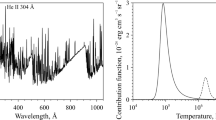Abstract
THE diffuse component of galactic radiation has been observed in various wavelength ranges, but few observations are yet available in the near infrared range. Since the interstellar extinction is rather weak in this wavelength range, one can obtain an overview of the galactic structure, such as the distributions of infrared sources and of absorbing matter from this region of the spectrum. We have therefore attempted a balloon observation of infrared radiation at the wavelength 2.4 µm with a band width 0.1 µm, avoiding intense OH airglow.
Similar content being viewed by others
References
Scoville, N. Z., and Solomon, P. M., Astrophys. J. Lett., 199, L105 (1975).
Haslam, C. G. T., Wilson, W. E., Graham, D. A., and Hunt, G. C., Astr. Astrophys. Suppl., 13, 359 (1974).
Berkuijsen, E. M., Astr. Astrophys. Suppl., 5, 263 (1972).
Metzger, P. G., The Spiral Structure of Our Galaxy (edit. by Becker, W., and Contopoulos, G.), 107 (1970).
Burton, W. B., Astr. Astrophys. Suppl., 2, 261 (1970).
Fichtel, C. E., et al., Astrophys. J., 198, 163 (1975).
Author information
Authors and Affiliations
Rights and permissions
About this article
Cite this article
HAYAKAWA, S., ITO, K., MATSUMOTO, T. et al. Infrared profile of Milky Way at 2.4 µm. Nature 261, 29–31 (1976). https://doi.org/10.1038/261029a0
Received:
Accepted:
Issue Date:
DOI: https://doi.org/10.1038/261029a0
- Springer Nature Limited
This article is cited by
-
The distribution of infrared sources in the galactic plane
Astrophysics and Space Science (1981)
-
Near IR surface brightness of southern galactic plane
Nature (1979)
-
The diffusion model of cosmic-ray propagation
Astrophysics and Space Science (1979)
-
Infrared profile of central region of our Galaxy at 2.47 µm
Nature (1977)
-
2.4-µm mapping of the galactic central region
Nature (1977)





